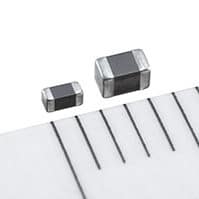source: TDK news
TDK Corporation presents the world’s first multilayer chip beads and inductors with the innovative soft-termination technology that is already proven in TDK MLCCs. The external electrodes of the new KMZ1608 and KPZ1608 series of chip beads and the KLZ1608 and KLZ2012 series of inductors feature a conductive resin layer that offers effective protection against board flexure and solder cracks due to mechanical stress during mounting and thermal shock during operation. As a result, these soft-termination automotive-grade components offer high reliability under harsh conditions, even at high operating temperatures up to 150 °C. They are thus suitable for demanding automotive applications, such as engine control modules (ECMs) and various in-vehicle electronic control units (ECUs), and advanced driver assistance systems (ADAS), as well as in a variety of industrial equipment.
The demand for compact, lightweight and robust multilayer inductive components is steadily growing as the electronic functionality of vehicles continues to increase and as more and more ECUs are positioned closer to the engine. The new KMZ1608 and KPZ1608 series of chip beads are available in IEC 1608 case size with dimensions of 1.6 mm x 0.8 mm x 0.8 mm. The KLZ1608 and KLZ2012 series are available in IEC 1608 and 2012 case sizes and measure in at 1.6 mm x 0.8 mm x 0.8 mm and 2.0 mm x 1.25 mm x 1.25 mm, respectively. The lineup of multilayer chip beads and inductors with soft terminations will be continuously expanded to include smaller case sizes. Volume production of the AEC-Q200 qualified products began in March 2017.
Glossary
Soft termination: The terminal electrode of standard products consists of three layers: copper (Cu), nickel (Ni), and tin (Sn) on the base electrode of Ag. The terminal electrode of soft-termination components consists of two layers: Ni and Sn bonded to the Ag base electrode with an elastic resin.
Main applications
- Engine control modules (ECM) and various in-vehicle electronic control units (ECU)
- Advanced driver assistance systems (ADAS)
- Industrial equipment
Main features and benefits
- Effective protection against board flexure and solder cracks
- Suitable for high operating temperatures up to 150 °C
Key data
| Series | Impedance [Ω] @ 100 MHz, ±25% |
DC resistance [Ω] max. |
Rated current [mA] max. | ||
|---|---|---|---|---|---|
| -55 to +125 °C | +125 to +150 °C | ||||
| KMZ1608 (signal lines) |
50 to 2500 | 0.1 to 0.8 | 200 to 800 | 100 to 400 | |
| -55 to +85 °C | +125 °C | +150 °C | |||
| KPZ1608 (power lines) |
30 to 1000 | 0.015 to 0.3 | 800 to 5000 | 500 to 2000 | 300 to 1000 |
| Series | Inductance [µH] ±20% |
DC resistance [Ω] ±30% |
Rated current [mA] max. |
|---|---|---|---|
| KLZ1608 | 1.0 to 22 | 0.15 to 2.4 | 55 to 190 |
| KLZ2012 | 1.0 to 100 | 0.10 to 3.7 | 30 to 700 |































